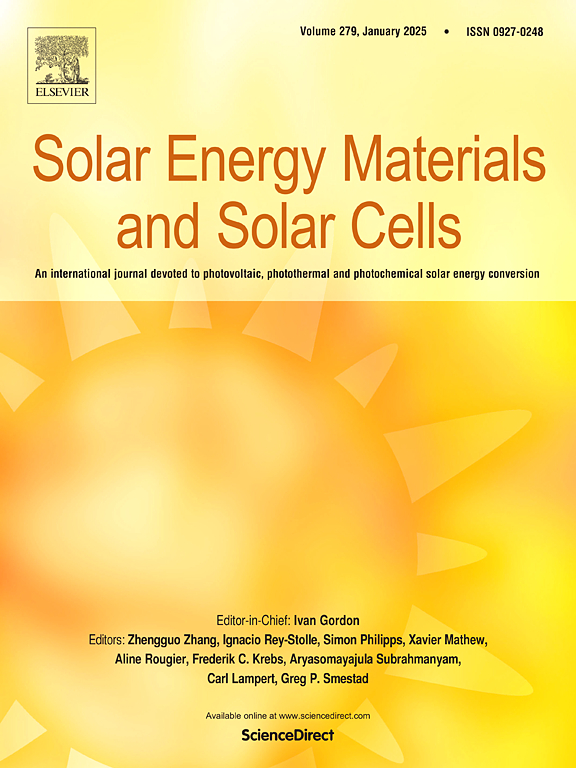Effect of carbon nanotubes in conductive adhesives for photovoltaics
IF 6.3
2区 材料科学
Q2 ENERGY & FUELS
引用次数: 0
Abstract
This study investigated the impact of adding carbon nanotubes (CNTs) to silver-loaded epoxy-based adhesives, focusing on mechanical adhesion, electrical performance, and reliability. CNTs improve electrical conductivity in polymers by forming conductive networks with a low percolation threshold, requiring significantly lower filler loading compared to micron-sized fillers. In this study, a commercial electrically conductive adhesive (ECA) is modified by adding 0.05 to 0.63 wt% of CNTs and several dedicated test structures are manufactured with it. The samples are stressed up to 2000 h under damp-heat and up to 400 thermal cycles. The results indicate that CNTs enhance peel strength, but only above a threshold concentration, with a 0.19 wt% addition increasing adhesion by 82 %, while higher concentrations yield diminishing improvements. The electrical performance is influenced differently: the sheet resistivity of ECA (Rs) improves with increasing CNT content, whereas the contact resistivity (ρc) initially increases before decreasing with higher CNT concentration. Under thermal cycling, higher CNT content mitigates Rs degradation, with the 0.63 wt% CNT formulation exhibiting superior long-term stability, though ρc degrades in all cases. During damp-heat exposure, Rs improves over time, while ρc degrades with increasing stress duration. Interestingly, Rs and ρc exhibit opposing trends, suggesting minimal overall impact on module performance (for the particular bill of material used in this study). The study also highlights the challenge of isolating the effects of CNTs from epoxy dilution, emphasizing the need for better control of the ECA formulations. These findings demonstrate the potential of CNT-enhanced ECAs for improved adhesion and electrical stability in photovoltaic applications, provided that trade-offs in contact resistivity are carefully managed to ensure long-term reliability.
碳纳米管在光伏导电胶粘剂中的作用
本研究研究了在负载银的环氧基粘合剂中添加碳纳米管(CNTs)的影响,重点关注机械附着力、电性能和可靠性。碳纳米管通过形成具有低渗透阈值的导电网络来提高聚合物的导电性,与微米级填料相比,碳纳米管所需的填料载荷要低得多。在本研究中,通过添加0.05 ~ 0.63 wt%的碳纳米管对商业导电胶(ECA)进行改性,并用其制造了几种专用的测试结构。样品在湿热和400次热循环下承受高达2000小时的应力。结果表明,CNTs可提高剥离强度,但仅在阈值浓度以上,添加0.19 wt%的CNTs可使附着力提高82%,而浓度越高,改善效果越弱。电阻率随碳纳米管含量的增加而提高,接触电阻率ρc随碳纳米管含量的增加而先升高后降低。在热循环下,较高的碳纳米管含量减轻了Rs的降解,0.63 wt%的碳纳米管配方表现出优越的长期稳定性,尽管在所有情况下ρc都会降解。在湿热暴露过程中,r随时间增加而增加,而ρc随时间增加而降低。有趣的是,r和ρc呈现相反的趋势,表明对模块性能的总体影响最小(对于本研究中使用的特定材料清单)。该研究还强调了从环氧稀释剂中分离碳纳米管影响的挑战,强调需要更好地控制ECA配方。这些发现证明了碳纳米管增强的ECAs在光伏应用中改善粘附性和电稳定性的潜力,前提是仔细管理接触电阻率的权衡以确保长期可靠性。
本文章由计算机程序翻译,如有差异,请以英文原文为准。
求助全文
约1分钟内获得全文
求助全文
来源期刊

Solar Energy Materials and Solar Cells
工程技术-材料科学:综合
CiteScore
12.60
自引率
11.60%
发文量
513
审稿时长
47 days
期刊介绍:
Solar Energy Materials & Solar Cells is intended as a vehicle for the dissemination of research results on materials science and technology related to photovoltaic, photothermal and photoelectrochemical solar energy conversion. Materials science is taken in the broadest possible sense and encompasses physics, chemistry, optics, materials fabrication and analysis for all types of materials.
 求助内容:
求助内容: 应助结果提醒方式:
应助结果提醒方式:


